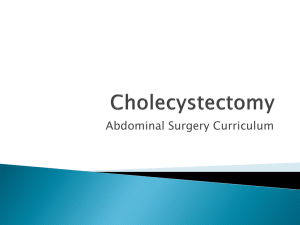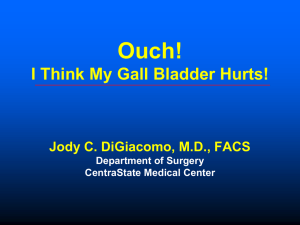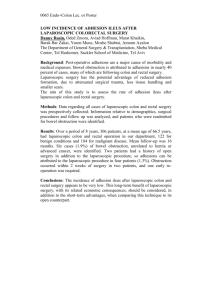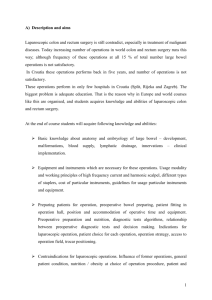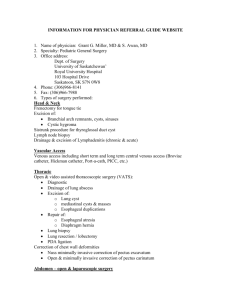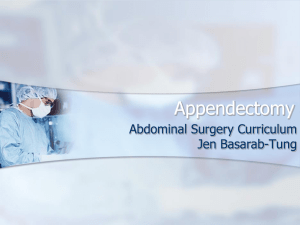ORIGINAL ARTICLE
advertisement
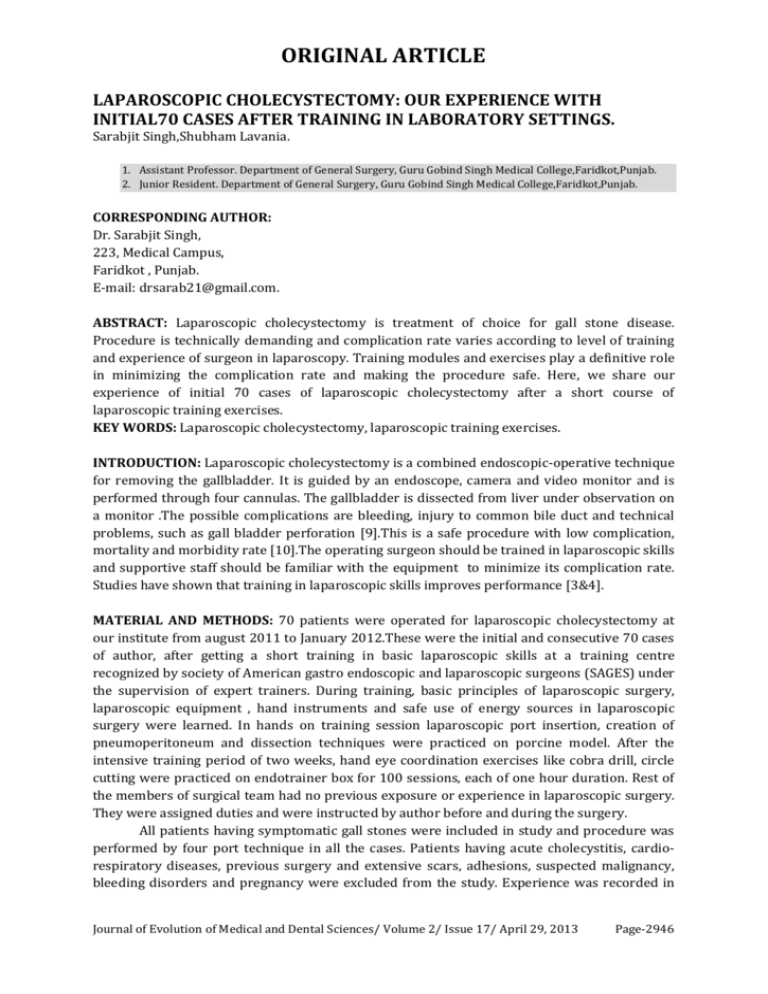
ORIGINAL ARTICLE LAPAROSCOPIC CHOLECYSTECTOMY: OUR EXPERIENCE WITH INITIAL70 CASES AFTER TRAINING IN LABORATORY SETTINGS. Sarabjit Singh,Shubham Lavania. 1. Assistant Professor. Department of General Surgery, Guru Gobind Singh Medical College,Faridkot,Punjab. 2. Junior Resident. Department of General Surgery, Guru Gobind Singh Medical College,Faridkot,Punjab. CORRESPONDING AUTHOR: Dr. Sarabjit Singh, 223, Medical Campus, Faridkot , Punjab. E-mail: drsarab21@gmail.com. ABSTRACT: Laparoscopic cholecystectomy is treatment of choice for gall stone disease. Procedure is technically demanding and complication rate varies according to level of training and experience of surgeon in laparoscopy. Training modules and exercises play a definitive role in minimizing the complication rate and making the procedure safe. Here, we share our experience of initial 70 cases of laparoscopic cholecystectomy after a short course of laparoscopic training exercises. KEY WORDS: Laparoscopic cholecystectomy, laparoscopic training exercises. INTRODUCTION: Laparoscopic cholecystectomy is a combined endoscopic-operative technique for removing the gallbladder. It is guided by an endoscope, camera and video monitor and is performed through four cannulas. The gallbladder is dissected from liver under observation on a monitor .The possible complications are bleeding, injury to common bile duct and technical problems, such as gall bladder perforation [9].This is a safe procedure with low complication, mortality and morbidity rate [10].The operating surgeon should be trained in laparoscopic skills and supportive staff should be familiar with the equipment to minimize its complication rate. Studies have shown that training in laparoscopic skills improves performance [3&4]. MATERIAL AND METHODS: 70 patients were operated for laparoscopic cholecystectomy at our institute from august 2011 to January 2012.These were the initial and consecutive 70 cases of author, after getting a short training in basic laparoscopic skills at a training centre recognized by society of American gastro endoscopic and laparoscopic surgeons (SAGES) under the supervision of expert trainers. During training, basic principles of laparoscopic surgery, laparoscopic equipment , hand instruments and safe use of energy sources in laparoscopic surgery were learned. In hands on training session laparoscopic port insertion, creation of pneumoperitoneum and dissection techniques were practiced on porcine model. After the intensive training period of two weeks, hand eye coordination exercises like cobra drill, circle cutting were practiced on endotrainer box for 100 sessions, each of one hour duration. Rest of the members of surgical team had no previous exposure or experience in laparoscopic surgery. They were assigned duties and were instructed by author before and during the surgery. All patients having symptomatic gall stones were included in study and procedure was performed by four port technique in all the cases. Patients having acute cholecystitis, cardiorespiratory diseases, previous surgery and extensive scars, adhesions, suspected malignancy, bleeding disorders and pregnancy were excluded from the study. Experience was recorded in Journal of Evolution of Medical and Dental Sciences/ Volume 2/ Issue 17/ April 29, 2013 Page-2946 ORIGINAL ARTICLE terms of technical difficulties encountered by surgical team, duration of surgery, intra-operative complications, post operative complications and hospital stay of patient. RESULTS: Intra operative complications we encountered cystic artery bleed in 2 cases (2.85%). Minor liver injury during trochar insertion occurred in 2 cases (2.85 %).There was no hollow viscous injury. Minor bleed from cutaneous vessels occurred in 3 cases (4.28 %) during port insertion. In 5 cases (7.14 %) there was gallstone spill in peritoneal cavity. This complication occurred due to perforation of gall bladder at the time of gall bladder extraction. However these stones were picked up and removed. Minor skin burn occurred in one patient (1.42%) due to improper contact of patient plate. This healed with antiseptic dressings. We had to convert 3 cases (4.28 %) to open cholecystectomy due to cystic artery bleed and dense adhesion around calot’s triangle. Average duration of procedures was 80 minutes. Post operative complications: Post operatively one patient (1.42 %) had minor bile leak from drain, which continued for about 10 days. Patient was managed conservatively and was discharged in satisfactory condition. One patient (1.42%) developed postoperative fever which lasted for 3 days and responded to antibiotics. Post operative pain in all the patients was relieved by moderate dose of non steroidal anti-inflammatory drugs. Requirement of analgesics was experienced only for first and second post-operative day. Average hospital stay was 2.5 days. DISCUSSION: In all the cases primary port was inserted at umbilicus by open technique. In 3 cases (4.28 %) it was inadvertently inserted in subcutaneous space. It was immediately recognized and corrected. We also had difficulty in manometric settings of insufflators and electrical connection settings in initial 5 cases. In initial 6-7 cases our suction and irrigation system was not ready. Either the machine was not plugged in or fluid container was not connected to irrigation cannula. This led to undue struggle and stress when there was intraoperative bleed leading to blurring of vision. We think this was due to lack of experience on the part of surgical team. Our nursing staff had no previous experience in laparoscopic procedures. So every time we demonstrated the instruments before starting surgery and intra-operatively there was lot of time lag in transferring desired instruments to surgeon. There was difficulty in extraction of stone filled gallbladder through epigastric port in 25 cases (35.71%). We think inappropriate traction and inadequate dilatation of tract led to perforation of gallbladder and spill of gallstones in 5 cases. Cautery burn occurred due to incorrect contact between patient and plate. We feel all these initial cases were performed safely except few minor complications. Execution of task could be made efficient and easier by better organization of team and going through a checklist of requirements. In a study conducted by Khan MW, Aziz MM etal, some serious postoperative complications occurred such as sub-hepatic abscess 0.02%, peritonitis due to gut perforation 0.04% and two deaths due to septicemia resulting from gut perforation [7]. Târcoveanu E etal has reported conversion rate of 5.1% in their study [8].In two other studies by Yi F, Jin WS et al and Hasbahceci M, Uludag M et al ,they have reported complications like liver bed injury (8%), spilled gall stones (7.25%), port site infection( 2.75%), vascular injury (4.5%), biliary leak (2.5%), bowel injury (0.75%), CBD stricture (1%),umbilical port hernia (0.5%) and common bile duct injury( 0.27%), postoperative bleeding in (0.45%) and mortality rate 0.13%.[11&12]. Journal of Evolution of Medical and Dental Sciences/ Volume 2/ Issue 17/ April 29, 2013 Page-2947 ORIGINAL ARTICLE In our experience complication rate was comparatively less than the complication rate in these studies. Studies have shown that laparoscopic training in laboratory settings improves performance in operation theatre settings. Structuralized box-trainer laparoscopic training significantly improves performance in complex virtual reality laparoscopic tasks [1]. Training on a virtual or physical box-trainer significantly amends duration and economy as well as movement precision in basic laparoscopic skills, and directly corresponds with the results achieved in a real operating theatre [2, 5 & 6]. Because of prior training and skill exercises we did not feel much difficulty in hand eye coordination and tissue handling during dissection. We were able to perform our first 70 cases safely and with minimal complications. So our experience suggests that laparoscopic cholecystectomy can be safely performed with minimal complications and risk after basic training in laparoscopic skills. Conflict of intrest : Authors do not have any conflict of interest. REFERENCES: 1. Dariusz Łaski, Tomasz J. Stefaniak, Wojciech Makarewicz, Monika Proczko, Zbigniew Gruca, and Zbigniew Śledziński. Structuralized box-trainer laparoscopic training significantly improves performance in complex virtual reality laparoscopic tasks.Wideochir Inne Tech Malo Inwazyjne. 2012 March; 7(1): 27–32. 2. Ahlberg G, Enochsson L, Gallagher AG, et al. Proficiency-based virtual reality training significantly reduces the error rate for residents during their first 10 laparoscopic cholecystectomies. Am J Surg. 2007;193:797–804. 3. Gruca Z, Kobiela J, Stefaniak T. Usefulness of surgical simulators in minimal invasive surgery education. Videosurgery and Other Miniinvasive Techniques. 2008;3:30–4. 4. Budzinski R, Michalik M, Frask A. Education in laparoscopic surgery. Videosurgery and Other Miniinvasive Techniques. 2008;3:22–9. 5. Ganai S, Donroe JA, St Louis MR, et al. Virtual-reality training improves angled telescope skills in novice laparoscopists. Am J Surg. 2007;193:260–5. 6. Wohaibi EM, Bush RW, Earle DB, et al. Surgical resident performance on a virtual reality simulator correlates with operating room performance. J Surg Res. 2010;160:67–72. 7. Khan MW, Aziz MM. Experience in laparoscopic cholecystectomy. Mymensingh Med J. 2010 Jan;19(1):77-84. 8. Târcoveanu E, Niculescu D, Georgescu S, Epure O, Bradea C.Conversion in laparoscopic cholecystectomy. TheChirurgia (Bucur). 2005 Sep-Oct;100(5):437-44.[Article in Romanian] 9. Gadacz TR, Talamini MA, Lillemoe KD, Yeo CJ.Laparoscopic cholecystectomy. Surg Clin North Am. 1990 Dec;70(6):1249-62. 10. Halilovic H, Hasukic S, Matovic E, Imamovic G. Rate of complications and conversions after laparoscopic and open cholecystectomy.Med Arh. 2011;65(6):336-8. 11. Yi F, Jin WS, Xiang DB, Sun GY, Huaguo D. Complications of laparoscopic cholecystectomy and its prevention: a review and experience of 400 cases. Hepatogastroenterology. 2012 Jan-Feb;59(113):47-50. 12. Hasbahceci M, Uludag M, Erol C, Ozdemir A. Laparoscopic Cholecystectomy in a Single, Non-teaching Hospital: An Analysis of 1557 Patients. J Laparoendosc Adv Surg Tech A. 2012 Mar 29. Journal of Evolution of Medical and Dental Sciences/ Volume 2/ Issue 17/ April 29, 2013 Page-2948 ORIGINAL ARTICLE Exercises on endotrainer box Dissection in laparoscopic cholecystectomy Difficulty in extraction of gall bladder Journal of Evolution of Medical and Dental Sciences/ Volume 2/ Issue 17/ April 29, 2013 Page-2949

